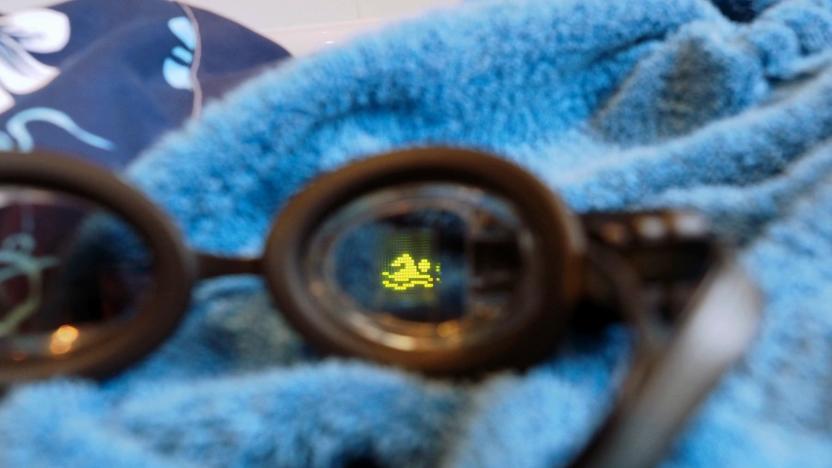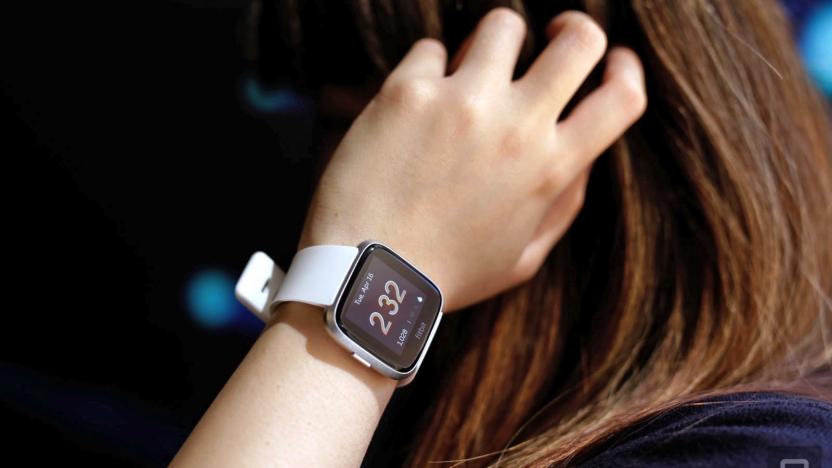health2019
Latest

The best apps for actually sticking to your fitness goals
Sticking to your fitness goals can be a challenge. But there are a number of apps that can help by providing motivation, teaching you new skills, and holding you accountable.
Daniel Cooper11.08.2019
How tech can improve everyday life for the elderly
Thanks to steady advances in modern medicine, humans are living longer than ever, but what's the point of passing that centennial mark if you can't enjoy your platinum years? Just because your body doesn't work as well as it did when you were 20 and practically indestructible, it doesn't mean you can't continue to enjoy a full and enriching retirement -- you just need a little help from technology.
Andrew Tarantola11.07.2019
The best fitness wearables
There are smartwatches, and then there are fitness wearables. And while it's easy to think they're the same, they aren't. The former offers deep integration with your phone and the option to use apps, music players and mobile payments. Those aren't to be mistaken with fitness watches, which have an emphasis on durability, reliability and accuracy. If you're looking for a watch that's less of a jack of all trades (just a master of a few), this is where we'd have you look.
Daniel Cooper11.06.2019
The apps and gear you need to get fit without breaking the bank
Getting in shape doesn't have to empty your bank account -- you don't even need a gym membership. Instead, there are budget apps and fitness gear you can use to get and stay in shape.
Andrew Tarantola11.05.2019
The best workout headphones
The gym can be a dull, boring place for some of us. Myself included. Fortunately, you've got a smartphone -- or an MP3 player. Whether it's for a music streaming service, a finely curated list of ripped tracks or a backlog of podcasts, what you need now are some workout headphones. It's 2019, and while not all wired headphones will work with your smartphone of choice, all phones have Bluetooth. There's also the fact that moving around with headphones, whether for a bench-press session or a run around the block, is better without wires. As long as your headphones stay put, that is. That's why all of our recommendations are wireless models. We've pulled together a few picks that should suit most workouts. While you can expect decent audio quality from all of them, decisions about workout gear, come down to personal preferences. Because of that, we've included over-ear models, noise-canceling champions and some reasonably priced headphones that punch above their weight.
Mat Smith11.04.2019
Get ready for a week of fitness and health tech on Engadget
Health and fitness tech is constantly evolving, making it easier to track your habits and progress. But it's not just Apple Watch ECGs, Couch 2 5K apps and smart kettlebells. A lot of features and services only require a smartphone you probably already own, while other advances can liberate people with mobility issues and disabilities. It's also big business, with a constant barrage of new wearables and fitness watches, apps and subscription services promising to make you healthier, stronger and fitter. How do you find the right device for you? How do you even start without spending a fortune? This week we'll be sharing advice across a variety of topics, including the best fitness wearables for any goal, and the smartest ways to get fit without breaking the bank. We're also helping you equip yourself to stay motivated with your longterm fitness goals and lay out some of the best gadgets for keeping people independent in their later years, spanning mobility, sight and hearing. We're kicking things off with a guide to the best workout headphones, which is live now. We'll be running a new story each day throughout the week.
Mat Smith11.04.2019
Nintendo's 'Ring Fit Adventure' hides grown-up workouts in a kids' game
I'm standing in the middle of my living room. Something resembling a garter belt is wrapped snugly around my left thigh. I'm squatting, fast. I may as well be twerking. I haven't had coffee yet. I'm supposed to be working. But this week, this is my work. It's fair to say I'm out of my comfort zone. After eight-plus years at Engadget, I'm testing my first game: Ring Fit Adventure, a new RPG for the Nintendo Switch that's out today. The game has players completing a series of full-body exercises to make their way through a scenic world. Along the way, you run (jog in place) and fly (flap your arms) to get from point A to B, and you "fight" enemies through a series of moves, ranging from squats to core work to yoga poses.
Dana Wollman10.18.2019
Form's Swim Goggles are the first great wearable for swimmers
What you're looking at sells why you'd ever want a pair of Form's new Swim Goggles more than any spec sheet or press release. Its transparent display sits over one of your eyes, serving up real-time stats about how well you're swimming, including your times, distances and splits. This is the same kind of data you see on TV during the Olympics, but now you're the superstar worthy of tracking. And it's all beamed straight to your face.
Daniel Cooper08.07.2019
Are period and fertility tracking apps effective?
Period- and fertility-tracking apps are nothing new, but they've seen a resurgence over the past few months. Traditional device makers like Fitbit, Garmin and Apple are beginning to incorporate the functionality into their wearables and smartwatches and some, like Garmin, are extending that functionality into standalone apps. While Apple had period-tracking in its Health app for awhile, the next iteration will soon let women know when their fertile period is, with or without the watch.
Nicole Lee07.24.2019
The tech elite athletes use
When a field of 127 runners lined up in Central Park on September 13, 1970, to run the first New York City Marathon, the only gadgets, per se, that could help them were a smattering of watches. A grainy finisher photo shows winner Gary Muhrcke breaking the tape with a watch band on his left wrist. Both of his hands are throwing peace signs. The only equipment required then was a pair of shoes, short shorts and enough grit to run 26.2 miles without collapsing. Today, running without a GPS watch is as much a protest against screen time and the intrusion of tech as it is a tactical racing decision. Some of us, meanwhile, can't imagine running without headphones. Then there's all the self-care. Vibrating muscle relaxers help athletes recover. Sport-centric social networks, like Strava, help us bask in our best workouts. Meditation apps help us calm down before bed while calorie counting apps track our macros. Even the most basic of fitness devices capture heart-rate data; on running watches, it will soon be standard. Speaking of sports watches, we have an entire buying guide for that, which we recently published as part of this outdoor gear series. But we were also curious about what it means to be better, faster, stronger when money is no object. We asked five elite runners, all of whom are flush with sponsorship deals and prize money, on what they use to train and how they protect their most important piece of equipment: their bodies. A couple of items on this list were universally recommended, namely the Hyperice Volt ($349) massage-ball gun (as I'm describing it) and NormaTec's compression boots ($1,295), both muscle-recovery tools. And, of course, plenty were eager to tout the wares of their sponsor partners. Here's what they're using.
Dana Wollman07.16.2019
Fitbit Versa Lite review: The basics aren't enough
I wasn't sure what to expect when Fitbit announced the Versa Lite smartwatch. It's supposed to be a pared-back iteration of last year's Versa, which itself was already a watered-down version of the company's first true smartwatch, the Ionic. For $200, the Versa was actually a pretty compelling mix of an Apple Watch-inspired design, capable fitness tracking and a robust operating system at a reasonable price. But it begs the question: How much more stripped down can you get? Apparently about $40 more. Fitbit somehow managed to squeeze $40 of tradeoffs out of the Versa to deliver the Versa Lite. It brings over most of my favorite features from the more expensive watch, but it might be too "lite" even for the first-time smartwatch buyers the company is targeting.
Cherlynn Low04.18.2019
Hydrow could be the Peloton of rowing machines
I would like to get in my time machine and explain to my college crew teammates what I'm looking at. It appears to be an ergometer (that's a fancy word for "rowing machine"), except the pull isn't a chain but a flat ribbon of fabric. There's no resistance lever on the side, and the underside is one big, swoopy curve, not unlike the hull of a boat. It has minimalist metal legs, similar to some TVs. Most important, there's a 22-inch screen attached, staring you right in the face. It's an erg from the future. As a college rower I dreaded the erg; using it felt lonely and monotonous. But I might have liked the Hydrow. As its creators describe it, it is the Peloton of rowing machines -- which is to say, it's an erg for the home, with a monthly subscription plan that includes live and prerecorded workouts hosted by a mix of instructors. The program also includes mat exercises meant to complement rowing, like yoga poses. Hydrow won't ship until May and has yet to receive some of its most compelling software features. But even in its early stages, it comes closer than anything else to capturing the sensation of rowing on water.
Dana Wollman03.28.2019